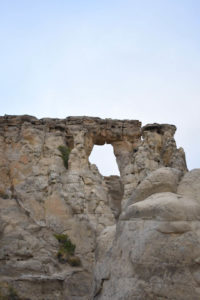 I sat perched several hundred feet up on the side of the crumbling sandstone cliff, looking out of the large hole that had been formed in its side. I gazed out at the vast expanse of land laid out below me, the hills of sage and towering white stone pillars reaching for the sky, and Missouri River lazily wondering between it all. Our class was visiting the aptly named “Hole-in-the-Wall” feature that was only a short walk from our campsite at Eagle Creek.
I sat perched several hundred feet up on the side of the crumbling sandstone cliff, looking out of the large hole that had been formed in its side. I gazed out at the vast expanse of land laid out below me, the hills of sage and towering white stone pillars reaching for the sky, and Missouri River lazily wondering between it all. Our class was visiting the aptly named “Hole-in-the-Wall” feature that was only a short walk from our campsite at Eagle Creek.
Once I drew my attention away from the view below me, I began to focus on the rock that I was surrounded by. It was covered in carvings of people’s names and dates from when they had made the climb up here. Some were recent, while others were from as far back as the early 1900’s. One man had visited five times with each new date neatly lined up under his name; interestingly enough, his birth and death dates were also carved into the stone. Even odder was the date for his last visit was listed as being two months after his death. “Maybe his family spread his ashes up here,” I wondered aloud. We may never know for sure if that is the case, but what is clear is that this was a special place for him. I ran my finger over the names, feeling the physical evidence of the individual’s connection to this place. I smiled thinking of all the people who had come here before me and all the people that would come here after. I felt a connection to these people who I do not and will never know, but who shared the same experience I was having now.
Not all the people in my class felt the same, however, and we ended up being split on who found the carvings cool and who disliked them. Some thought that the carvings were in poor taste. That they detracted from other people’s future experiences in this place by permanently altering the stone. Now no one will ever be able to see this place in its natural, untouched state.
That discussion pulled me back to a hike we had gone on the day before. It had been raining and we had our hoods pulled up against the weather, our boots leaving footprints alongside the cow tracks in the mud. When we made it to our destination it looked like any other section of sandstone cliff that encircled the valley we were staying in. However, upon closer inspection we soon found a single name carved into the stone. It was the name of the rancher who had homesteaded here in 1904. He had carved his initials and year here to claim his ownership of the land.
Then our instructor drew our attention to another section of the rock face. There we saw an even older carving. A petroglyph of a horse carved by a member of one of the native tribes who had lived in the area hundreds of years ago. We do not know the exact date or meaning behind the petroglyph besides it being carved sometime after the 1600’s, after the introduction of the horse to the Americas. It might have been made to indicate horse in the area or maybe the individual just felt moved to create it. The two carvings are only 20 or so feet apart on the rock face, but they are separated by a vast distance of time and culture.
As I returned my mind to the newer carvings I sat in and among, I realized that not one of my classmates had protested the rancher’s initials or the petroglyph. We had all gazed with wonder and admiration at the petroglyph and with a historical curiosity at the initials. I wondered what makes one more acceptable than the other. Is it time? The older the thing is the more accepting we seem to be of it? I am not sure of the answer, but as I thought about it, I came to realize that all the people who had carved into the soft sandstone from the tribal member, to the rancher, to the visitors at Hole-in-the-Wall, all had a deep connection to this place. Humans’ relationship to this land has changed over time and that evolution can be seen in what we have left behind. To me, the carvings at Hole-in-the-Wall are not an obnoxious form of graffiti, but a continuation of the long history of human connection to the land.